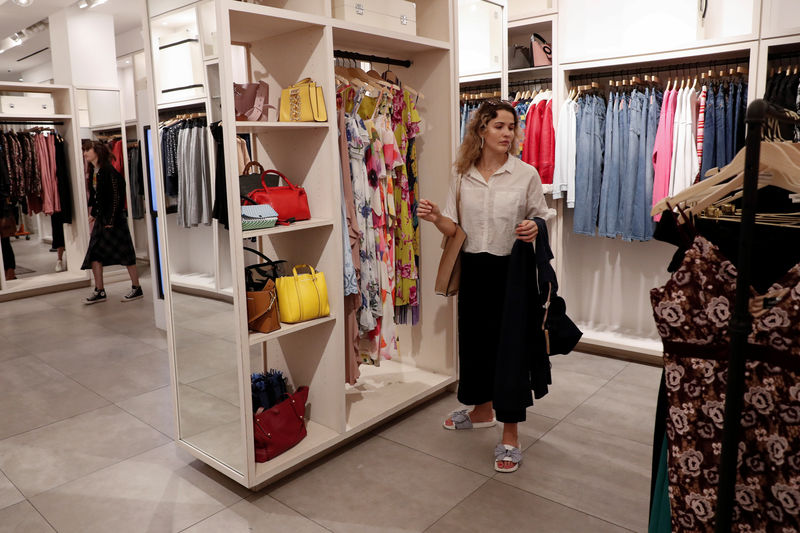By Sonya Dowsett and Melissa Fares
MADRID/NEW YORK (Reuters) - Lisa Batitto, 54, says she has virtually stopped buying clothes ever since she started renting them.
The New Jersey-based museum publicist spends $277 (221.9 pounds) a month on three subscriptions, including one from New York & Company, a women's mid-price clothing chain with hundreds of U.S. stores.
This is less than what she previously spent, she said. "I still have clothes in my closet from when I was buying, but I can't tell you the last time I bought anything," she said.
From New York & Company, owned by RTW Retailwinds Inc. (N:RTW), to Bloomingdale's (N:M) and Banana Republic of Gap Inc. (N:GPS), more retailers are offering to lend out their clothing for a monthly rental rate.
Even fast-fashion stalwart H&M (ST:HMb), with nearly 5,000 stores globally, said in August it would include a limited rental service featuring its premium-priced collection made from recycled fibers in a revamped central Stockholm store.
The services cater to a growing number of people like Batitto who want to purchase just a few items and rent the rest.
But the strategy comes with risks. It costs a lot to ship items back and forth, and it remains to be seen if rental clothes will cannibalize retail sales over the longer term.
Fees roughly range from $50 to $160 per month to rent several items, with an option to buy at a discount. While most services are online, some stores are creating space for people to drop off, browse or collect clothing available for lease.
(For a graphic on "Rental" apparel services model, click https://graphics.reuters.com/RETAIL-RENTING/0100B2B71DH/rent-the-runway.jpg)
San Francisco-based fashion rental service Le Tote bought the operations of Lord + Taylor stores from struggling Canadian department store operator Hudson's Bay Co (TO:HBC) last month. Inside the next nine months, it plans to build drop-off lockers and large display areas in 38 Lord + Taylor department stores.
Competitor Rent the Runway has expanded its physical drop-off network over the past year with 25 points for customers to return garments in its own stores plus some WeWork locations and Nordstrom stores in the Los Angeles area.
Rent the Runway can turn around an item in as little as a day, a company spokeswoman said. The company opened a 300,000 square foot fulfilment centre in Texas in July in addition to its New Jersey facility to deal with increased demand.
The risk is rental services could take spend away from traditional sales in a sector where changing shopping habits and falling prices have nearly halved the percentage spend on apparel by the average U.S. consumer over the past 30 years.
In addition, physical stores are struggling with online competition from players like Amazon (NASDAQ:AMZN). Year-to-date announced store closures have already exceeded the total recorded for 2018, said Coresight Research in a recent note.
The U.S. garment rental market, excluding costumes, was worth $1 billion in 2018, less than 1% of the total apparel market, according to GlobalData. But it grew 24% in that year compared to 5% for the wider clothing market, data shows.
That growth can come with a hefty price tag.
At Le Tote, once subscribers drop off boxes containing up to 15 items of clothing, a chain of activity will start to ready items for their next assignment. Le Tote currently ships boxes to its online subscribers using USPS Priority.
"Shipping is our biggest cost, so having these stores as touch points for customers to come in, pick up and drop off significantly reduces our shipping costs," Chief Executive Rakesh Tondon said in an interview.
CaaStle, a New York-based company that provides technology and logistics for the New York & Company, Bloomingdale's and Banana Republic rental services amongst others, branched out from its own Gwynnie Bee women's apparel business in 2018 to set up rental services for others.
Contrary to analysts' concerns that rental could cannibalize sales, offering rental captures more revenue as consumers buy clothes in addition to their subscription, said CaaStle Chief Executive Officer Christine Hunsicker in an interview.
Rental platforms buy clothing wholesale from brands, but many are introducing revenue-sharing models whereby platforms allow brands to upload items for lease and then take care of cleaning and delivery in return for a share in the revenue.
This model is better for cash-flow but not as profitable, said Le Tote CEO Tondon. Le Tote raised around $75 million over the past five years from investors including Azure Capital, Sway Ventures and Google (NASDAQ:GOOGL) Ventures, and has been profitable at the operating level for over three years, he said.
Jeans maker Levi Strauss & Co (N:LEVI), which operates under a revenue-sharing model with Rent the Runway, has increased offerings on the platform from 12 items when it launched in November to 29 currently, including skinny jeans and embroidered denim jackets.
"When the product comes back, they put it back to like-new," Levi's Chief Executive Chip Bergh said in an interview.
Brands from Levi's to upmarket U.S. label Rebecca Taylor - whose silk dresses retail at hundreds of dollars - are putting more stock to rent to open new revenue streams, capture new customers and harvest valuable feedback, they say.
Tiarra Phillips, an 18-year-old college student from a small town in Georgia in the southern United States pays $69.95 a month for her subscription to Express, a fashion mall brand whose rental service is also powered by CaaStle.
Phillips said she has never been to one of Express's network of over 600 physical stores, but has rented items ranging from leggings to dresses.

"They tell you not even to wash it, to just wear it and send it back and then you get a new box, so I don't really have to do anything; I can just sit at home," she said.